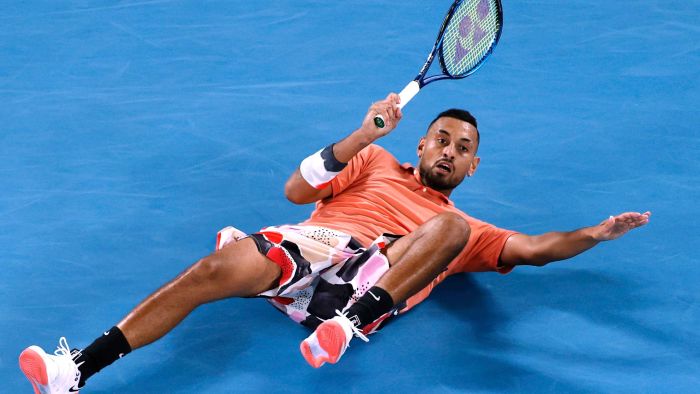Amid the unending gloom of Melbourne’s winter in stage four lockdown, the sight of empty tennis clubs and courts — usually hives of community and sporting activity — was among the eeriest.
I live far from the city, and one advantage of that is open space. Our local tennis club has 14 courts — 11 en tout cas and three rebound ace.
In my teens and 20s, with siblings and friends, I’d always book the rebound ace so we could avoid bagging the court afterwards.
Of course, plenty more onerous chores than that fall on the army of volunteers who keep such clubs running for 52 weeks every year, not just the fortnight of the Australian Open, when every hack with a dusty Wilson Pro Staff in the garage decides it’s time for a hit.
It is a fact almost unacknowledged now, but it was the egalitarian nature of Australian tennis clubs — their openness not just to all shapes and sizes, but ages and income brackets — that underpinned the country’s dominance of the sport until the late 20th century.
We take our tennis clubs for granted. So, perhaps, does big-time tennis.
The latter could be seen most obviously in the justifications put forward in recent months when the Australian Open was at risk of cancellation, none of which mentioned the grassroots game.
The more pressing concerns: Australia risked losing the big show for good if another country stepped into the breach; tourism dollars were under threat; broadcasters demanded bang for their buck.
What Tennis Australia couldn’t cover via its $80 million emergency fund was gladly loaned by the Victorian Government, which is all in on the event until at least 2039.




On their behalf, Novak Djokovic whined about quarantine conditions.
Not unreasonably, the Melbourne public raged. For most of 2020, spotting COVID-19 protocol breaches in the Instagram stories of tennis stars had been a competition more notable than the matches themselves. Were we really risking it all for a millionaire’s lawn party?
What nobody said was that it was good for tennis as a community project which pre-dates the modern, mega-millions incarnation of the grand slam event.
Indeed, many clubs are not funded at all by the Australian Open windfall, instead managing meagre resources, a mostly volunteer workforce, making money only so they can exist.
Arguably, they’d continue to do so no matter where the tournament was played.
Eyes on Kyrgios for Monday night




Now, another annual tradition arrives: How will Nick Kyrgios — reborn during the pandemic as an “only sensible guy in the room” figure — fare this time?
In the third round, Kyrgios has drawn world number three Dominic Thiem, an Austrian opponent to rank with The Terminator. We should probably just enjoy it while he lasts.
Kyrgios’s story is an interesting combination of the two tennis worlds above.
Much has been made of his flashiness. But like many Australian champions of the past, he emerged from the “nowhere” of the unpretentious and efficient club scene.
In June last year, during Melbourne’s unfortunately brief period of COVID-safety, I ventured to Canberra in search of Kyrgios’s tennis beginnings.




A small part of the puzzle can be found at the O’Connor Tennis Club, seven kilometres south of Parliament House but a world away from the luxury-brand billboards of the pro tour.
The club’s entrance is unmarked, its car park the continuation of a dirt road, and the clubhouse attached is no more imposing than a toilet block.
There I met Kyrgios’s first mentor, Andrew Bulley, immediately identifiable as a tennis coach: squinting, lithe, effusive.
He’d just finished coaching a mother-daughter duo so deliberate in their techniques that they’d allow the ball to bounce twice before committing to shots. Bulley must have taught thousands of similar players, but he still seemed to be having fun.
Fifteen years ago, he would watch for the cloud of dust as Kyrgios’s grandmother pulled up to the courts in her hatchback.
Knees up near his face, Nick would climb out and cheekily complain about playing on Lyneham’s “dirt” (the other courts where he practised in those years are now gone). Grandma would sit on the bonnet and spark up a dart. The child prodigy would commence blasting incredible shots to all corners of the court.
Bulley’s memory is that the kid always knew where the next ball would land before it had been hit. His other lasting impressions were of how hard Nick’s father Giorgos (“George”) worked, that Nick’s mother Norlaila was always urging discipline and application, and that Nick preferred talking about basketball and video games.
In the years since, plenty have wondered how different things might have been for Kyrgios if Bulley had coached him for a few more years.




When Kyrgios was 14, Tennis Australia and the AIS took him away, appointed their own coach and began the process whose result is unfulfilled talent.
Kyrgios hasn’t even kept a coach on staff for what should have been the salad days of his professional career.
Too modest to offer his own theories, Bulley continues to do the sorts of things that tennis club people do: He strings Kyrgios’s rackets.
He also wonders whether he’ll ever have another student wander into a lesson and unleash such wonders. But how different would things be? His other top juniors have been taken away too.
Watching Kyrgios on TV, Bulley is unable to switch off his coach’s brain. When things are too easy or too hard for Kyrgios, he can identify the same glazed look of boredom he spotted in the child.
On Monday night, like the rest of the country, he’ll watch him again.
Then he’ll get up on Tuesday and start again — another day, another player, another session, another tennis court bagged, paying no mind to the plushness of Djokovic’s pillows or the pile of money he’ll take home.







